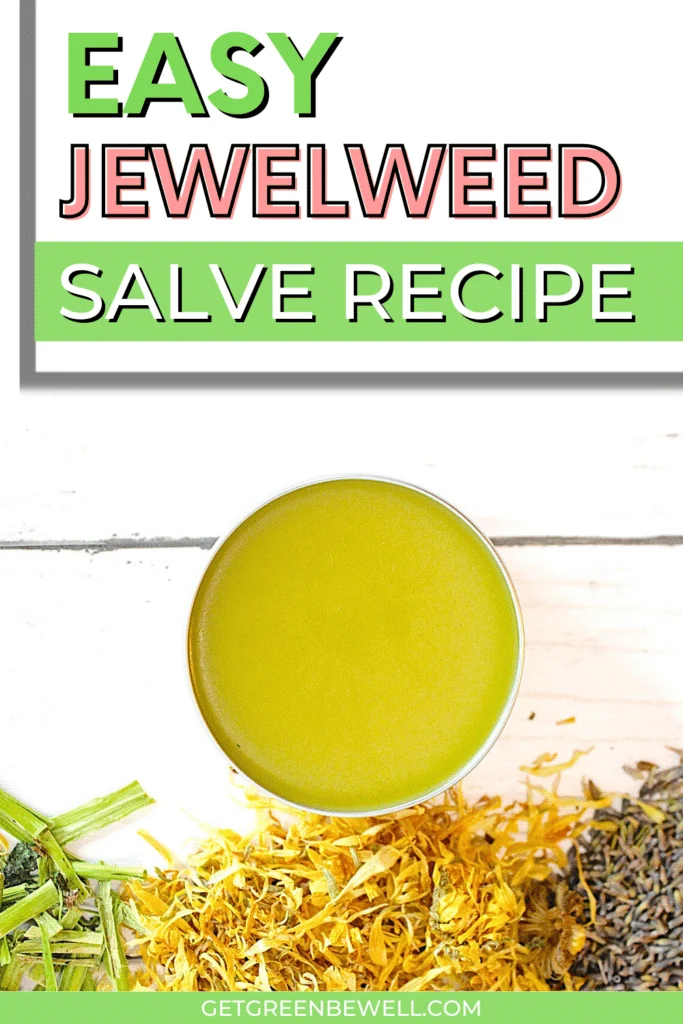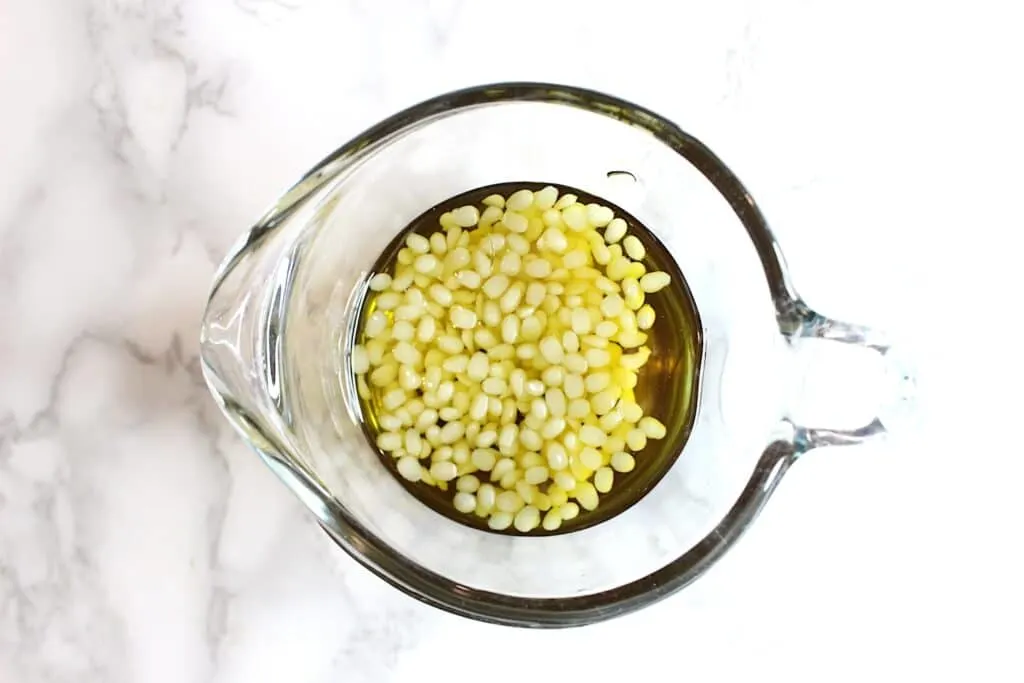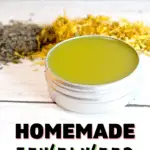A DIY Jewelweed Salve can help alleviate itchy bug bites, skin rashes, hives and poison ivy or poison oak. This all-natural salve is packed with herbal goodness from wildflower plants that you can harvest in the wild or your backyard.

What is Jewelweed?
Jewelweed, also known by its scientific name Impatiens capensis, is a beneficial plant that thrives in moist, shaded environments. The wildflower is often spotted along stream banks, in damp woods, and in other wetland areas.
This native North American plant is easily recognizable by its trumpet-shaped, orange flowers speckled with red or brown spots, resembling little jewels — thus earning it the name “jewelweed.”
These vibrant flowers bloom from late spring to early fall, adding a splash of color to the green undergrowth. The flower is sometimes called a Spotted Touch-Me-Not because it bursts open at the slightest touch.
Not only is this wildflower pretty, jewelweed is highly regarded for its natural therapeutic properties. It has been used traditionally by many Native American tribes for treating a variety of skin irritations, such as the itchy rashes caused by poison ivy and stinging nettles.
The liquid and oils in this plant contain compounds that have anti-inflammatory and antipruritic effects, making it a go-to remedy in folk medicine.

Jewelweed Salve Uses
A homemade jewelweed salve is important to have on hand for many uses, including:
Jewelweed for Poison Ivy and Poison Oak
A clinical trial found that jewelweed is effective in reducing a poison ivy rash.
The secret to its effectiveness lies in compounds known as saponins, which give jewelweed with anti-inflammatory and antipruritic (reducing itching) qualities. A study published in the Journal of Ethnopharmacology found that jewelweed mash minimized the skin irritations caused by poison ivy when applied topically.
In addition to the soothing effects of this poison ivy salve, jewelweed also exhibits anti-inflammatory and antimicrobial properties, thanks to its natural saponins, which create a soap-like emulsion when the plant’s leaves and stems are crushed.
In fact, jewelweed soap is smart to have on hand just in case you get exposed to poison ivy.
Insect Bites and Bee Stings
Just like poison ivy and poison sumac rashes, insect bites can cause discomfort, swelling and lots of itching. This herbal botanical salve can help reduce inflammation and reduce the desire to scratch the skin.
Rub this gentle salve on bee stings and bug bites such as:
- Mosquito Bites
- Biting Flies
- Spider Bites
- Wasp Stings
- Bee Stings
- Gnat Bites
- Chiggers
Itching skin can sometimes lead to infection, which is why the antimicrobial properties of this gentle herbal salves is beneficial to the skin. It can help prevent infection.
Skin Rashes
Any type of rash, hives or red, inflamed skin can be helped by this herbal salve.
The anti-inflammatory properties will help to reduce swelling and irritation from a variety of issues such as eczema, heat rash, etc.
Antimicrobial properties will help prevent infection that can occur when the skin is being scratched because of itching.
Scrapes, Burns, Small Cuts
A homemade jewelweed salve is great for all kinds of skin irritations, including minor cuts, burns and scraped skin.
The natural anti-inflammatory and antimicrobial properties of this herbal salve can reduce pain and prevent infection without the need of a chemical-based ointment.
If you prefer a topical mist, see our DIY Jewelweed Spray.

DIY Jewelweed Salve Recipe
This easy jewelweed salve recipe can be made in just a few minutes and kept on hand in your natural medicine cabinet. Our recipe makes two 2-oz. tins.
We added a few other flowers to add in some more beneficial properties, but you do not need to add them in for an effective salve.
The recipe for how to make jewelweed salve uses a jewelweed oil, which must be prepared a few weeks ahead of time to harness the beneficial properties of the wildflower if using an easy slow-infusion method, as we did. Or you can use pre-made jewelweed oil available on Etsy.
Ingredients
- ¼ cup jewelweed (we used dried jewelweed)
- ¼ cup dried lavender flowers
- ¼ cup dried calendula flowers
- ¾ cup avocado oil (or any other carrier oil)
- 1 ½ tablespoons beeswax

Directions
Step 1
Add the jewelweed, calendula, and lavender into a glass jar, such as a mason jar.


Then pour in the avocado oil to fully cover the ingredients.
Cover the jar with an air-tight lid and keep it in a cool, dark place for a 3-4 weeks. Shake the jar every few days to redistribute the oil.
When ready to make the homemade salve, strain the flowers and plant parts out of the oil.

Step 2
In a double boiler or a heat-safe bowl placed over a pot of simmering water, melt the infused oil and beeswax pellets to become a liquid.

Step 3
Once melted, pour the mixture into tins.
Allow to cool for a few hours or overnight, until the mixture is opaque and not see-through.


Store in a cool, dry place away from sunlight which can cause it to melt.
Helpful Tips for How to Make Jewelweed Salve
- This salve recipe makes about two 2-oz tins.
- You can use any carrier oil that you want, such as sweet almond oil, olive oil, grapeseed oil or coconut oil.
- Adding the calendula and lavender is not necessary, so you can leave them out.
- You may add in essential oils if you would like for other beneficial properties or to add a pleasant scent. Add these in after melting the oil and beeswax together and stir into the mixture before pouring into the tins.
- The stems and leaves are used for the benefits of jewelweed. It is not necessary to harvest the flowers.
- Dried jewelweed is commonly used in making a jewelweed salve. You can use fresh parts of the plant, but watch out for mold potentially developing when slow-infusing the oil.
Save this DIY Jewelweed Salve Recipe by Pinning It to Pinterest.

If you like this easy jewelweed salve recipe, be sure to see these ideas next:
- Rose Salve Recipe
- DIY Rosemary Salve
- Star Anise Salve
- Plantain Weed Salve
- Menstrual Cramp Salve
- Comfrey Salve




